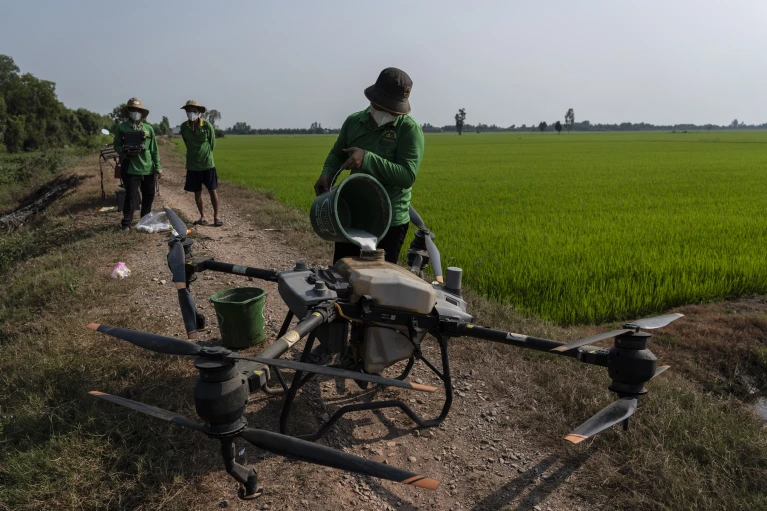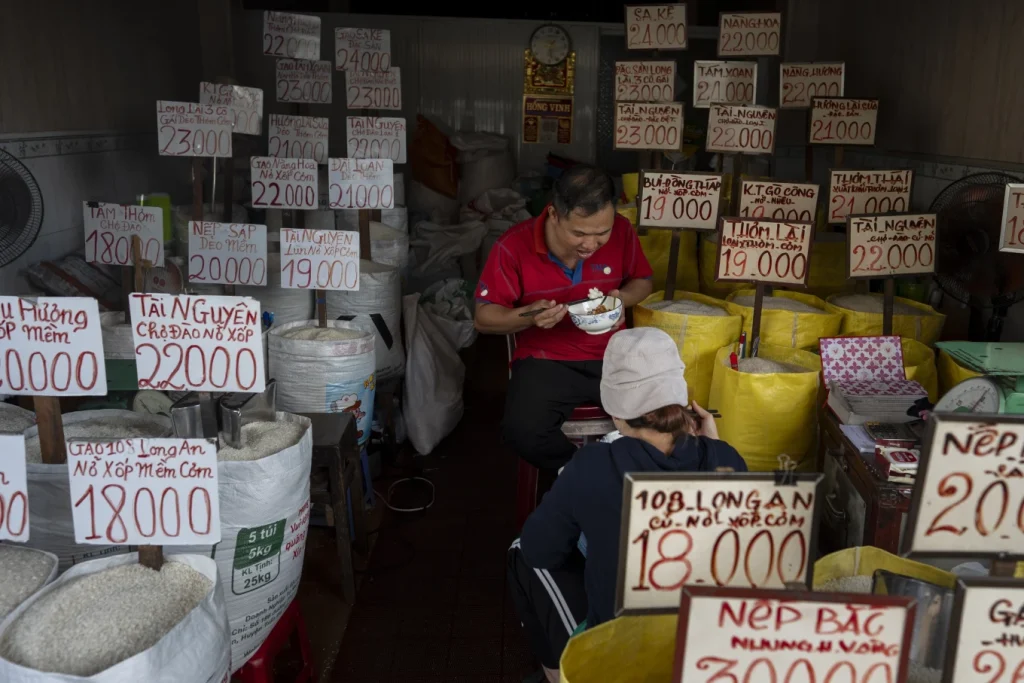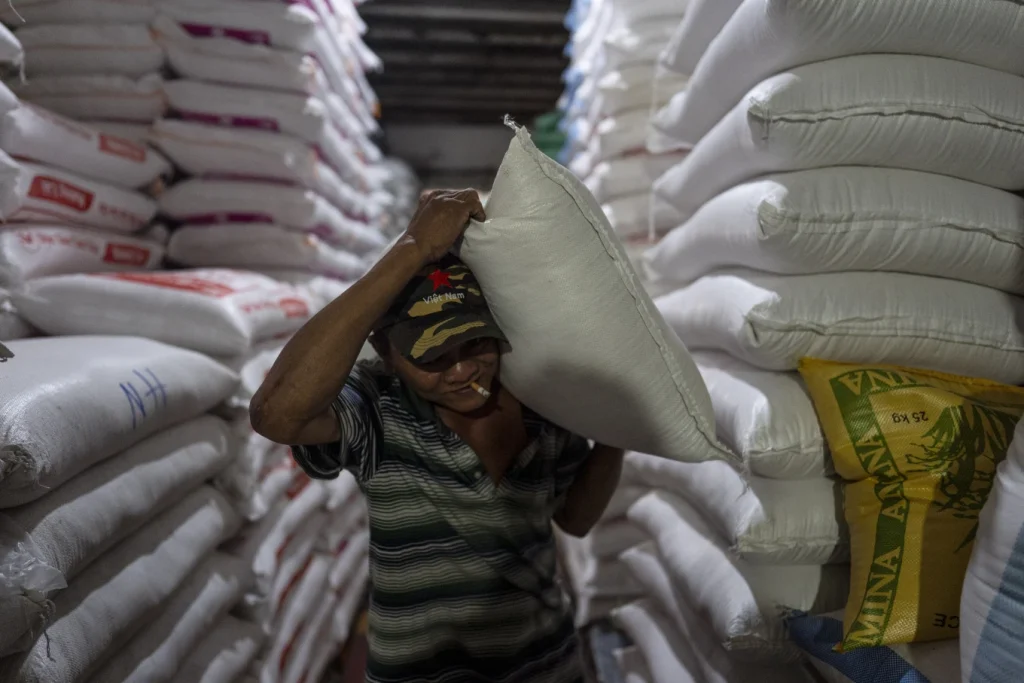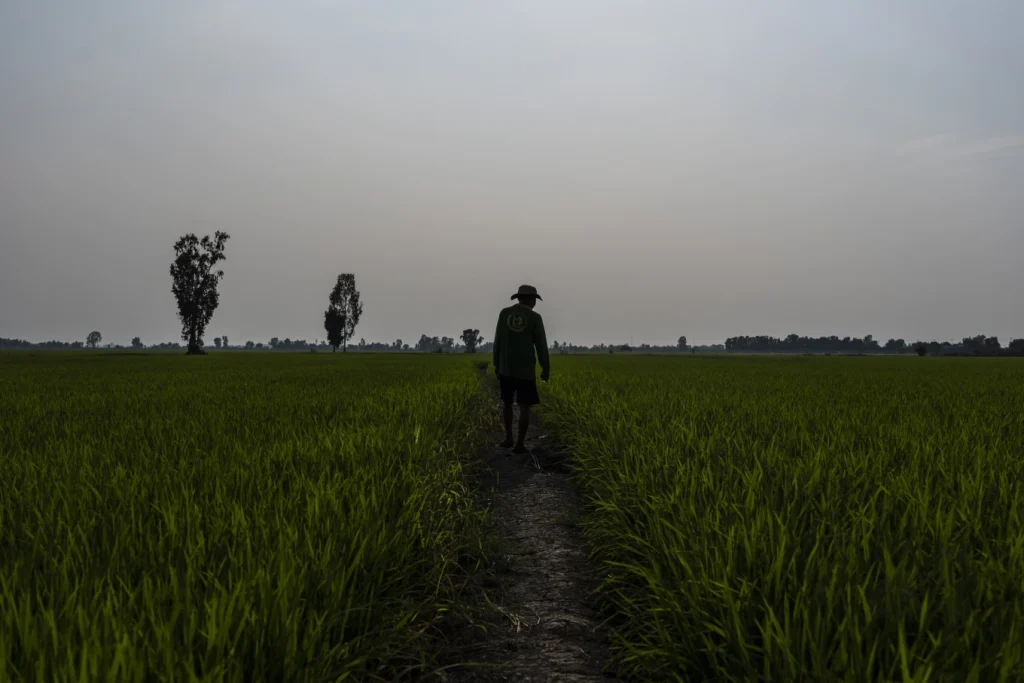Long An, a province nestled in the verdant landscapes of southern Vietnam’s Mekong Delta, is home to a tapestry of rice fields that have sustained communities for generations.
Amidst this picturesque setting, one farmer stands out for his innovative approach to rice cultivation. Vo Van Van, a 60-year-old farmer, has embarked on a journey to revolutionize traditional farming practices by embracing sustainable techniques that not only enhance crop productivity but also mitigate the environmental impact of rice cultivation.
At the heart of Van’s agricultural experiment lies a radical departure from conventional methods. Unlike the vast majority of rice fields in Long An province, Van’s fields are not entirely submerged in water.
This departure from the norm is a crucial step towards reducing water usage, a precious resource in the face of escalating climate change.
By adopting this water-saving approach, Van not only conserves a vital resource but also challenges the age-old notion that flooded fields are indispensable for successful rice cultivation.
Furthermore, Van’s utilization of a colossal drone, resembling an eagle in flight, adds a futuristic dimension to his farming practices.
The drone, equipped with organic fertilizer, hovers gracefully above the lush expanse of rice seedlings, showering them with nutrients in a precise and efficient manner.
This innovative technique not only minimizes the labor-intensive process of manual fertilization but also reduces the environmental footprint associated with conventional fertilization methods.
The adoption of these cutting-edge practices underscores Vietnam’s commitment to addressing the dual challenge posed by rice cultivation: its susceptibility to climate change impacts and its significant contribution to greenhouse gas emissions.
The traditional method of cultivating rice in flooded fields not only demands substantial labor and water inputs but also results in the release of methane, a potent greenhouse gas with a far greater warming potential than carbon dioxide.

The paradox of rice cultivation lies in its unique relationship with methane production. The anaerobic conditions created by flooded fields provide an ideal environment for methane-producing bacteria to thrive, leading to the emission of significant quantities of this potent greenhouse gas.
According to a recent report by the Food and Agriculture Organization, rice paddies account for 8% of all human-made methane emissions, underscoring the urgent need for sustainable solutions in rice cultivation.
Van’s pioneering efforts symbolize a paradigm shift in the agricultural landscape, where innovation and sustainability converge to create a path towards climate resilience.
By embracing water-saving techniques and precision agriculture, Van not only enhances the productivity of his rice fields but also mitigates the environmental impact of his farming practices.
His journey serves as a beacon of hope for farmers across the region, inspiring them to adopt sustainable innovations in their quest for a more resilient and eco-friendly future.
In conclusion, Vo Van Van’s story epitomizes the transformative power of innovation in agriculture. His bold experimentation with sustainable techniques not only challenges conventional wisdom but also paves the way for a more sustainable and climate-resilient future.
As the global community grapples with the challenges of climate change and food security, Van’s example serves as a testament to the potential of human ingenuity in overcoming adversity.
By reimagining age-old practices and embracing cutting-edge technologies, farmers like Van hold the key to a more sustainable and prosperous tomorrow for generations to come.
Vietnam, a country known for its rich cultural heritage and breathtaking landscapes, holds a special place in the world as the third-largest rice exporter.
The significance of rice in Vietnamese culture is undeniable, especially in the Mekong Delta, where the fertile fields and waterways have sustained the population since the end of the Vietnam War in 1975.
Rice is not just a staple food in Vietnam; it is considered a divine gift and is revered by the people.
The versatility of rice is evident in the myriad ways it is consumed and utilized in Vietnamese cuisine. From being molded into noodles and sheets to being fermented into wine, rice plays a crucial role in the daily lives of the Vietnamese people.

In bustling markets, motorcyclists can be seen transporting bags of rice to their homes, while barges carry massive quantities of rice along the Mekong River.
The process of harvesting, drying, hulling, and packaging rice is a labor-intensive task that involves modern machinery and traditional methods.
One individual who is at the forefront of innovation in rice farming is Van, who works with the Loc Troi Group, one of Vietnam’s largest rice exporters. Van has been implementing a method of irrigation known as alternate wetting and drying (AWD), which requires less water than traditional farming practices.
By not continuously submerging the paddy fields, Van’s farm produces less methane and conserves water, making it a more sustainable option for rice cultivation.
In addition to adopting AWD, Van has also incorporated drone technology into his farming practices. Using drones to fertilize the crops not only saves on labor costs but also ensures precise application of fertilizers.
This method is crucial in preventing over-fertilization, which can lead to the release of nitrogen gases that contribute to global warming.
As climate change continues to pose challenges to agriculture, including unpredictable weather patterns and water scarcity, innovative approaches like AWD and drone technology are essential for the sustainability of rice farming in Vietnam.
With an increasing trend of rural-to-urban migration, finding labor for traditional farming practices has become more difficult, making the adoption of modern techniques even more crucial.
In conclusion, rice holds a sacred place in Vietnamese culture, and its importance goes beyond just being a source of sustenance. Through innovation and adaptation, farmers like Van are leading the way in ensuring the sustainability of rice farming in Vietnam.
As the country continues to thrive as a major rice exporter, it is essential to embrace modern agricultural practices that not only preserve the environment but also ensure food security for future generations.
Increasing the genetic diversity of rice varieties can have numerous benefits, as highlighted by Nguyen Van Nhut, the director of the rice export company Hoang Minh Nhat.
Nhut emphasized that certain rice varieties exhibit greater resilience to extreme heat or require less water for growth. In addition, some varieties may even emit lower levels of methane, a greenhouse gas contributing to climate change.

By incorporating these resilient rice varieties into their supply chain, Hoang Minh Nhat’s suppliers are better equipped to handle challenging environmental conditions, such as briny water and intense heat.
However, Nhut also acknowledged the challenges posed by unseasonal rains, which can hinder the traditional sun-drying process for rice and increase the risk of mold or insect infestations.
To address this issue, the company is investing in drying facilities at their packaging factory and considering the installation of machinery for drying rice closer to the fields.
Nhut noted the unpredictability of the rainy season, underscoring the need for adaptive strategies in the face of changing climate patterns.
